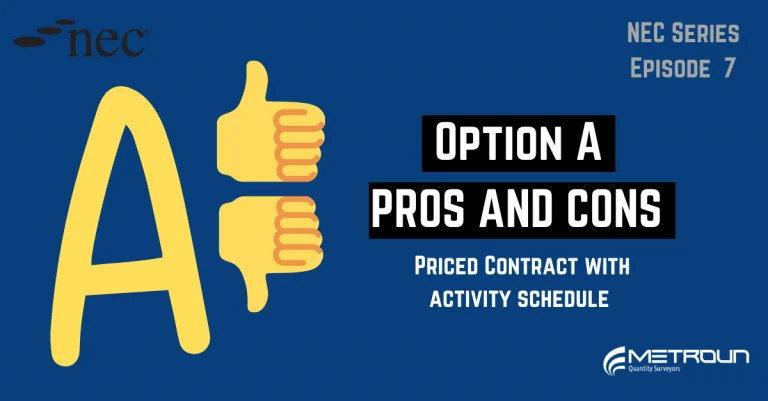The NEC4 Engineering and Construction Contract (ECC) contains an array of core and optional clauses. These clauses are used to develop the terms and conditions of a particular construction contract.
NEC4 ECC Clauses
1. Core Clauses – These clauses form the main body of the contract. Although often amended slightly to suit the client’s requirements. It’s recommended these are left mostly untouched so the aims and objectives of the NEC4 are upheld.
2. Main Option Clauses (A,B,C,D,E & F) – To supplement the Core Clauses, a Main Option Clause must be selected. This will determine how risk is shared between parties and by what means the contractor is reimbursed. You can find our article and video on these clauses here
3. Secondary Option Clauses (X,Y & Z) – These are optional bolt on clauses which can be implemented into a contract. X & Y being a selection of pre-written clauses and Z clauses which are completely customisable prior to contractual agreement.
Under NEC4, there are 7 different options for procuring work. This article will provide descriptions of how each option works and explore the pros and cons to establish which option works best for you. Briefly, the options are titled as follows:
Main Option Clauses
- Option A: Priced contract with activity schedule
- Option B: Priced contract with bill of quantities
- Option C: Target contract with activity schedule
- Option D: Target contract with bill of quantities
- Option E: Cost reimbursable contract
- Option F: Management contract.
- Option G: Term contract
So what is NEC Contract Option A?
To put simple, this option is a priced lump sum contract. The price is then broken down into an activity schedule.
Interim payment is made upon the completion of;
1. Each group of completed activities (without defect)
2. Each completed activity not within a group
Mostly used upon appointment of a contractor to carry out; infrastructure, highways, buildings & process plants. Can be used regardless of the level of design responsibility.
Programme of Works
The accepted programme is essential for this option and will need to be regularly updated as works progress. All stakeholders of the construction project should have key input into the programme acceptance.
The programme is linked to an activity schedule. This not only provides information on when activities will be completed, but also gives reasonable indication to when payment will be made. An unrealistic programme could have an effect on: cashflow, time penalties and potential CEs.
Variation Administration
Under this option, the contractor carries most of the risk for work being carried out under the agreed price. That said, there are almost always unforeseen changes to the scope and/or site information which could lead to a variation. Under the NEC, these variations are known as Compensation Events. If the contractor is made aware of an event which will affect the price of works, they must submit CE notification within 8 weeks of becoming aware of that event.
If the contractor encounters an event which they deem could have an impact on the price of works. They should issue an Early Warning Notification as soon as they become aware of that event.
The timely issuing of notifications is essential to the NEC’s collaborative way of working. Continuous communication between all parties will ensure disputes are kept to a minimum.
The pros and cons of this contract will depend on if you’re a Client or Contractor. However, should the contract be administered properly, the benefits can be mutual.
Cost and Value
For the Client, how much the works cost the contractor is mostly irrelevant. The focus for the client is the value of works carried out. This will determine how payment is made and variations are assessed.
For the contractor, continuous monitoring should take place on the difference between the value and cost. This is slightly less important under cost contracts like option C,D &E. However, under option C it’s imperative the contractor keeps on top of their outgoings. For example, monitoring of, subcontract management, task efficiency and good Quality Management Systems (QMS) to keep defects to a minimum.
Pros of NEC Option A:
· Simplified payment process – it’s easier to assess when a group of activities is completed rather than the measuring of work completed as is required on Option B
· For clients – Greater cost certainty then with Target Cost options
Cons of NEC Option A:
· For contractors – there is no provision for part payment, if there is an issue with completing a group of activities, no payment is made until the group is completed
· For contractors – unlike option B, the contractor holds the risk for errors within the price
Watch our video on NEC Option A here:











